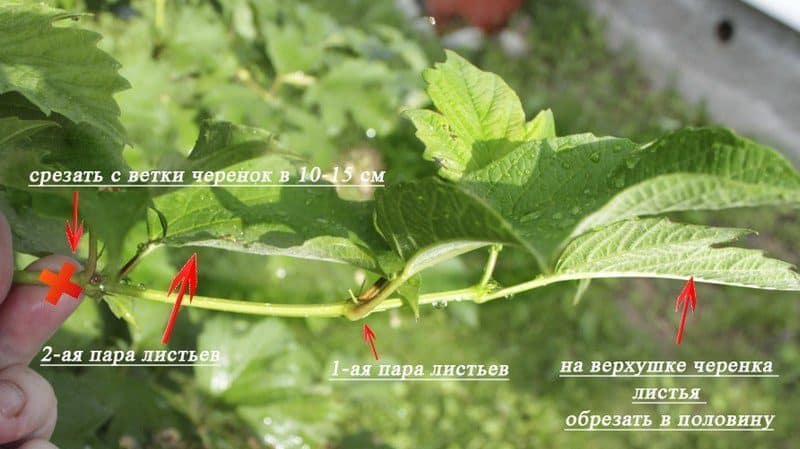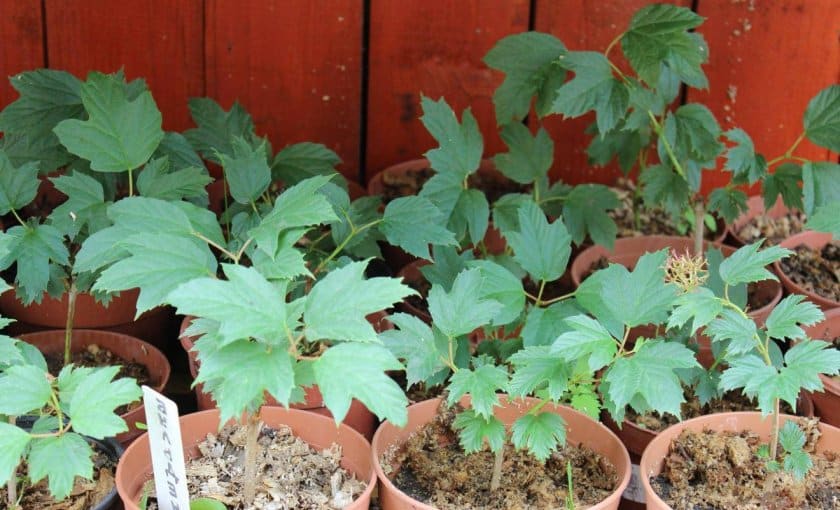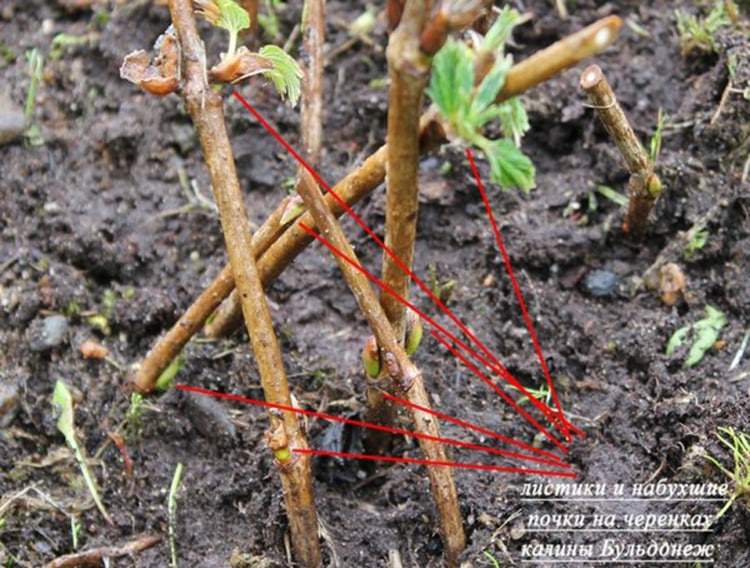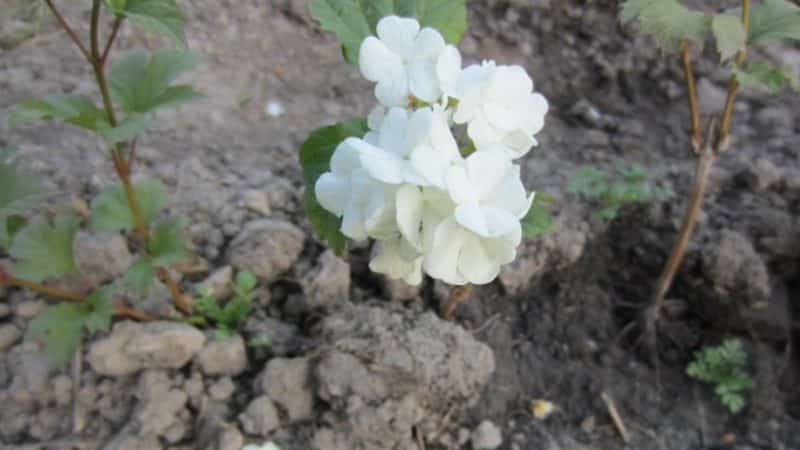A clear guide to propagating viburnum Buldenezh by cuttings in spring
Viburnum buldenezh is an ornamental shrub with lush white inflorescences in the form of balls. The plant is used in landscape design to decorate the local area. In the article we will talk about the propagation of viburnum buldenezh by cuttings in the spring, the rules for their preparation, planting and further care.
How does ornamental viburnum reproduce?
Viburnum buldenezh is an ornamental shrub that does not go unnoticed in the garden. The plant attracts the attention of passers-by with tall bushes with snow-white inflorescences in the form of balls, which gradually change shade as they bloom.

The bushes reach 3 m in height, although the plant is classified as a low-growing shrub. The crown is thick and lush, painted bright green.
Reference! Translated from French, Boule de Neige means “snowball”.
Viburnum buldenezh reproduces exclusively by vegetative means, since its flowers are sterile. The main methods of propagating shrubs are cuttings, layering and seedlings.
Layers are most often used. They are taken from a bush more than a year old, with strong lower branches, under which shallow depressions are dug. The grooves are watered abundantly and organomineral fertilizers are applied. The selected branches are tilted to the ground and secured with arcs of thick wire.
The tops are left open. Shallow cuts are made on the bark of the cuttings to stimulate root formation, completely covered with soil and watered. in autumn rooted cuttings are disconnected from the mother bush and planted in a new place.
Reference! Reproduction by layering is carried out in the spring, and by dividing the bush in the fall, before the onset of the first frost.
Propagating viburnum by dividing the bush or seedlings is another common and effective method. To do this, select a bush with daughter shoots and carefully dig it out. Next, branches with a complete root system are separated from the mother plant. The procedure is performed carefully, trying not to damage the bush.
Is it possible to propagate viburnum buldenezh by cuttings?
Viburnum cuttings are carried out in the summer. This method is the most gentle, although it is less popular among gardeners. Its main advantage is that the prepared cuttings quickly take root in a new place after planting, and the plant itself does not experience severe stress. The disadvantage of this method is that it is labor intensive.
Timing for cuttings
Decorative viburnum cuttings are harvested in mid-spring and early summer. The procedure is performed depending on the type of shoots chosen for pruning. In the spring, woody shoots are harvested. The optimal period is April-May.
In June, green cuttings are cut, which coincides with scheduled bush pruning. During this period, it is convenient to select healthy shoots.
Selection of cuttings

The success of propagation of viburnum buldenezh depends on the quality of planting material. Gardeners practice propagation by green and woody cuttings.
Green cuttings are cut from young branches up to a year old. To do this, choose smooth stems without signs of infection by insects and fungi. Limp, dry, broken branches will not survive after planting. On each cutting, 2 pairs of internodes are left.
Lignified cuttings are cut from branches covered with bark. The shoots must be healthy and straight, without damage or signs of infection. On each cutting, 2 pairs of internodes are left.
Harvesting and care rules
In order for the cuttings to take root after planting, it is recommended to follow a number of rules for their preparation:
- The length of the shoots should be 6–10 cm, with 4 buds left on each of them.
- The lower cut should be oblique, at an angle of 45°, and pass over the kidney, the upper cut should be straight, under the kidney.
- The lower leaves are torn off, and a cut is made on the upper ones, shortening them in half.
- Cuttings with buds are immersed in a solution of “Kornevin” or heteroauxin for 12 hours.
After treatment in a growth stimulator, rooting is performed in one of the following ways:
- Stick cuttings into a peat tablet, and then into a plastic glass, having first filled it with 1 cm of water. A plastic bag is pulled over the container and placed in partial shade. After the first roots appear (usually this happens after 3 weeks), the cuttings are transplanted into pots, covered with a bag and placed on a sunny windowsill. After 2 weeks, the containers are transferred to fresh air and buried in a shaded place until spring.
- Cuttings are planted immediately in open ground. Beds are formed in the selected area, the soil is mixed with humus in a 1:1 ratio and watered abundantly. The cuttings are deepened by 2–2.5 cm and covered with film or plastic bottles. For better rooting, plantings are watered regularly.

Choosing a landing site
For planting viburnum buldenezh, choose areas located in partial shade. The culture does not like too intense lighting: in direct sunlight, the leaves begin to dry out and curl. Not suitable for growing shrubs and the place is too dark.In this case, the viburnum blooms sparingly and for a short time.
Ornamental shrubs love moisture, so it is advisable to choose places near water bodies for planting. It is important to ensure that there is no stagnation of water in the area.
This is interesting:
Is it possible to dry viburnum and how to do it at home
Choosing fertilizer for currants in spring: what and how to fertilize the bushes for a good harvest
Soil preparation
The soil must contain the optimal amount of nutrients and allow air to pass through. The suitable type of soil for the plant is loam or sandy loam, acidity is 5.5–6.5 units.
Advice! To normalize the pH, add slaked lime or dolomite flour (400–500 g per 1 m2).
To increase nutritional value, the soil is mixed with peat, humus, compost and mineral fertilizers. For example, 30 liters of compost are combined with 400 g of wood ash and 200 g of nitrophoska.
How to properly plant cuttings of viburnum bulldonezh

Planting cuttings is carried out in the summer, observing a number of rules:
- The size of the hole should be 2 times the volume of the rhizome together with the earthen lump. The roots of decorative viburnum are developed, so the recesses must completely accommodate them. For planting cuttings, prepare holes 70–80 cm deep and 60–70 cm in diameter.
- Expanded clay, broken brick, crushed stone, and tree bark are placed at the bottom of the pits. A layer of nutritious soil is poured on top, leveled and 7–10 cm of clean soil is added so that the earthen ball is at the level of the soil surface.
- The seedling is placed strictly in the center and the roots are carefully straightened. The hole is filled with nutritious soil and compacted.
- A watering circle is formed around the planting hole and the soil is abundantly moistened with warm, settled water.
- The beds are mulched with bark, peat, and compost to retain moisture and prevent weed growth.
What mistakes to avoid
Situations are possible when the cuttings are planted correctly, but the plant still does not bloom. This happens when:
- deepening the root collar during planting;
- lack of regular moistening of the bushes;
- strong shading or excessive lighting of the plant;
- deficiency of mineral and organic fertilizers;
- the presence of fungal infections and damage by insect pests.
With proper care and following all recommendations, Viburnum buldenezh will delight you with abundant flowering for a long period.
Further care

Caring for viburnum buldenezh after planting involves:
- Abundant watering to maintain flowering. To regularly moisten adult bushes, 30–40 liters of clean, settled water is sufficient, for young plants – 10–20 liters. Before the onset of cold weather, moisture-recharging irrigation is performed to protect the root system from freezing.
- Spring and autumn feeding. If necessary, the bushes are fertilized in the summer, until mid-August. For this, wood ash, humus, compost, potassium and phosphorus are used.
- Annual pruning. It helps the crown look well-groomed and beautiful. The procedure is performed after flowering, during the formation of new buds. At the end of August and beginning of September, thinning pruning of bushes is carried out. The leaves and ends of the branches are trimmed with garden shears, giving the bush a neat appearance.
The main pests of ornamental viburnum are bark beetles, leaf beetles, cruciferous flea beetles, and aphids. The most dangerous period is the end of spring, when insects begin to attack plants.
To prevent the spread of pests, the bushes are treated with a solution of wood ash (400 g per 10 liters of water) or a soap solution (100 g of laundry soap per 10 liters of water).At the height of infection, viburnum is sprayed with insecticides: Fitoverm, Iskra, Aktellik, Karbofos, Fufanon.
Conclusion
Viburnum buldenezh reproduces exclusively by vegetative means: cuttings, layering and seedlings. Its snow-white flowers are sterile and do not bear fruit, so seed propagation is not possible. Green cuttings are harvested in the summer, lignified ones in the spring.
Treatment with growth stimulants and further rooting guarantee high survival rate after planting. Caring for decorative viburnum involves abundant watering, application of mineral and organic fertilizers, pruning and treatment against insects.